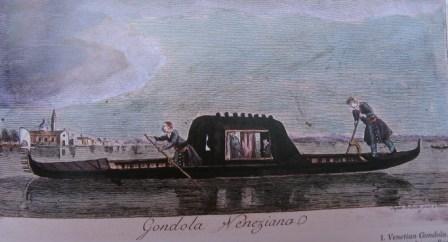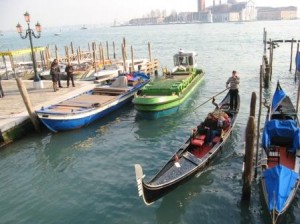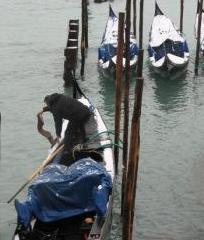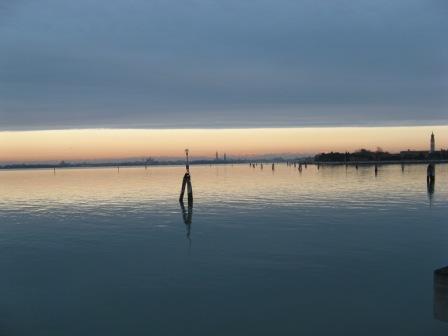
The daily cri di coeur (that would make a great newspaper name) comes via the Gazzettino from Paolo Lanapoppi, a Venetian and former president of an association called Pax in Aqua, about which much more some other time.
Lanapoppi felt compelled to write to the Gazzettino, even as the wind whistled through the windmills toward which he was spurring his horse, so to speak, to take issue with the latest jab which mayor Massimo Cacciari had made to the few remaining morons who insist on living in his city and dare to criticize its administration.
A day or so earlier, Mr. Cacciari had brushed aside a discouraging word from some constituent with the brusque observation that Venetians are “piangnoni” (crybabies, kvetchers, whiners) and Mr. Lanapoppi sees it quite differently. I’m translating his missive here not because I want to spoil your day, as I know you have problems of your own to think about, but because it summarizes very eloquently some basic points which deserve to be criticized here, and why.
Venetians are crybabies? Who has governed the city since 1993? We need a new governing class (August 27, 2009)
It seems incredible. As the number of residents continues to fall and the city is clogging up with vacation rooms for rent, trash in the shop windows, tourist launches, day-trippers, the mayor is declaring that the city needs to free itself from the monoculture of tourism. He even goes so far as to say that Venetians have to stop being crybabies.
But who governed the city from 1993 to 2000? Cacciari. And from 2000 to 2005? Paolo Costa, elected with the support of Cacciari. And from 2005 till today? Cacciari again, naturally.

So who is supposed to be battling the monoculture of tourism? The opposition? Or the elderly in their nursing homes? Or we members of a thousand organizations which fight every day to have a little space in the newspapers to denounce an unsustainable situation, and that find ourselves at thousands of conferences and round tables being snubbed by the administrators?
So to the damage they’re now adding mockery: we’re being accused of being snivelers. Instead, there’s Cacciari fighting the tourism monoculture, inaugurating new museums as if they were for the 60,000 residents, who inaugurates new piers as if they were nursery schools for the Venetians, who sets up a brand-new dock for the tourist launches in the Riva dei Sette Martiri, who ignores and lets languish an area of tremendous potential like the waterfront in Marghera, who has not succeeded in many years to create even one great center for research or for work, who goes to the Biennale and the Film Festival to do “culture,” who sells the facades of the palaces under restoration for publicity.
One sees the desire to get out of the tourism monoculture, one sees it clearly. All you have to do is look at what the Cacciari government is doing.
Then, on the same day, the vice-mayor, Michele Vianello, comes out with an incredible quip: To put an end to the motondoso in the Bacino of San Marco, what we need is a single authority. That he would have the courage to say so after five years of the commissioner (N.B.: against motondoso, as well as mayor) Costa would be amazing if it weren’t offensive to the intelligence of his listeners. Because there’s something else that is needed: What’s needed are people in power who have the capacity and the will to make changes. Venice — and notable people such as Riccardo Calimani, Francesco Giavazzi, Gherardo Ortalli, have said it unanimously and in public — has not been capable of producing a class of governors worthy of its history and its potential.
It has been, at the most, a springboard for launching people who are seeking national notoriety; meanwhile, the city is crumbling under the suction of the propellors (another reference to motondoso) and is being transformed by the pressure of 20 million voracious grasshoppers (tourists) a year. As for the future, one hears predictions of 40 million in another 20 years. We’re already preparing the hotels of the future Tessera City (the village near the airport) and the under-lagoon subway to facilitate their arrival.
Nice way to get out of the monoculture of tourism.
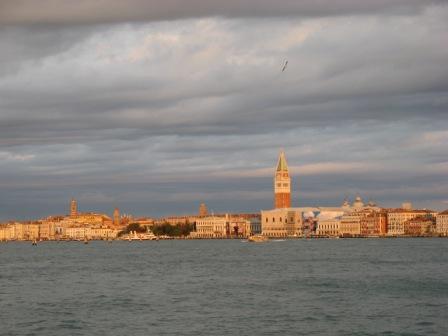



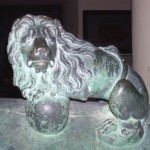
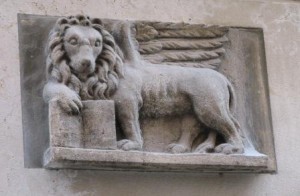
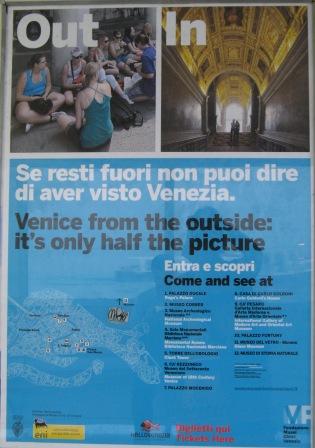 I think somebody has already recognized this and decided to play to Venice’s currently somewhat battered image. A new campaign promoting the city’s museums shows two scenes: One is a detail of the huddled masses in the Piazza San Marco, next to a shot of the magnificent Scala d’Oro in the
I think somebody has already recognized this and decided to play to Venice’s currently somewhat battered image. A new campaign promoting the city’s museums shows two scenes: One is a detail of the huddled masses in the Piazza San Marco, next to a shot of the magnificent Scala d’Oro in the 